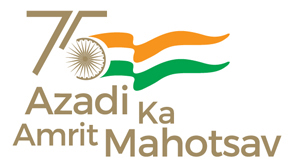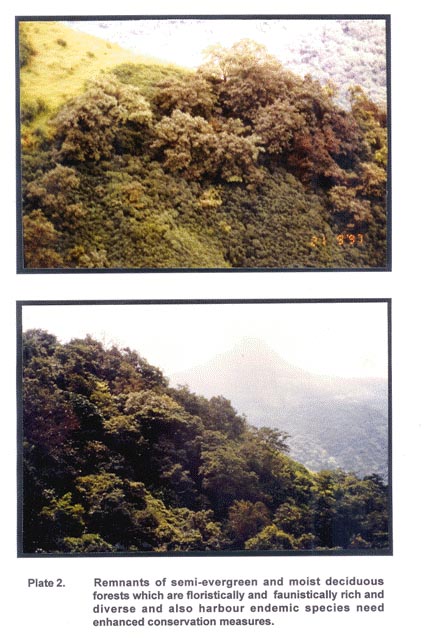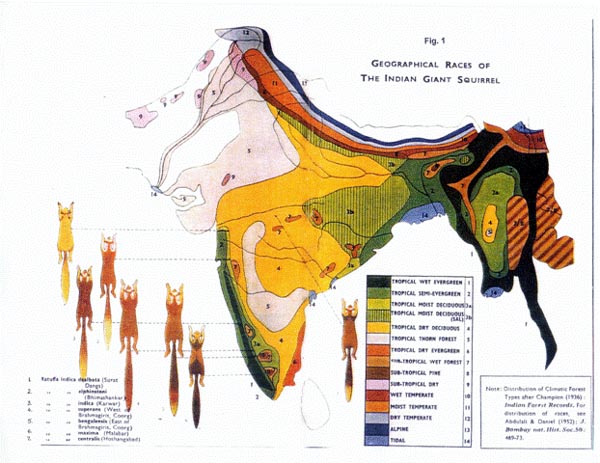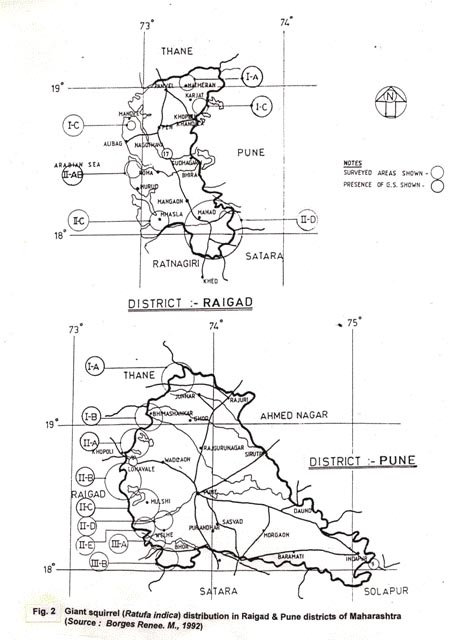Diversity
|
The Western Ghat zone is perhaps the most diverse only second to Himalaya, the diversity here meaning the variability of plants and animals inhabiting diverse habitats. Moist Deciduous Forests along high elevation in the valley, Semi Evergreen Forests along the higher elevation and crestline, grasslands and scrublands on the plateau and the coastal belt offer a diversity of natural ecosystems and wildlife habitats (Plate 2). Floral diversity: It has been estimated at present that the flora of Maharashtra is composed of 181 families, 1082 genera and 3225 species which occur in wild (Karthikeyan et al., in press). Of these, 1573 species, 4 sub species, and 16 varieties of flowering plants belonging to 684 genera spread over 128 families are known to occur in the North Western Ghats. The Borghat which is the part of the North Western Ghats in Maharashtra support a fairly large proportion (9%) of the 4500 species of flowering plants known from the Western Ghats in only (10%) of its representative area in the Maharashtra State. The flowering plants of Western Ghats in the Khandala region are represented by 150 trees, 77 shrubs, 95 climbers and 434 herbs (Appendix VI, VII, VIII & IX). Several taxonomic groups have contributed to the floral diversity and floristic richness of the Western Ghats of Maharashtra as is even evident from Table 6. Table 6. Floristic components of the North-Western Maharashtra
(Source: Jagtap, A.P. 1997) Some of the largest families of flowering plants which are represented by large number of species in Western Ghats of Maharashtra are Poaceae (186), Fabaceae (180), Orchidaceae (86), Acanthaceae (70) and Cyperaceae (63). Species richness alone cannot be the criterion for a measure of floral diversity in the Western Ghat which is also the largest habitat for several genus. Dalbergia which has 25 species reported from India has 22 representatives in Western Ghats (Nair, 1986) and Impatiens, an annual herb that has 175 species in India is represented by 77 species in Western Ghats (Abraham, 1986). Orchidaceae is represented by 30 genera (Kumar, 1986) and Poaceae by 58 endemic genera of which 47 are monotypic (Abraham, 1986). Faunal diversity: The Western Ghats are also a home to a large number of faunal groups represented by several species. Table 7 provides a summary of the faunal wealth of Western Ghats. Table 7. Faunal wealth of Western Ghats
(Source: Jagtap, Ajit P. 1997) In the Western Ghats area of the Maharashtra State, Evergreen, Semi-Evergreen and Moist Deciduous biomes are rich in species, particularly of birds (Appendix X) and herpetofauna. Panther, Dhole, Gaur, Malabar giant squirrel, Bonnet macaque, Common langur and Palm civet are amongst the significant mammals reported from the project area (Appendix XI). Beside this, smaller mammals like Barking deer, Mouse deer, Common mongoose, Black naped hare and Pangolin also occur in the Ghat areas. The drier forest offers habitat for Sambar, Chital and Chowsinga and some reptilian species. The moist areas along the streams and marshland are habitats for a variety of amphibians species. Western Ghats have one of the richest amphibian fauna in South Asia. Here amphibians are represented by 24 genera and 107 species under eight families and three orders. Of these 28-30 species of amphibians under 6 families are also reported from Maharashtra (Jagtap, 1997). In addition, the wildlife diversity of the representative units of Western Ghat i.e., tropical evergreen, semi evergreen, scrub forest, grasslands and wetlands is represented by 48 genera of mammals, 82 species of reptiles, 58 species of lizards (Murthy, 1983; Tikader and Sharma, 1992) and 232 species of birds (Gole, 1997). A number of the species recorded and reported from these areas fall in Schedule I of the Wildlife (Protection) Act, (GOI,1972). These include Loris, Mouse deer, Giant squirrel and Pangolin. In the Western Ghats, 5 species of non-human primates and 5 species of squirrels are represented. Of these, Slender loris and Bonnet macaque are found throughout the Western Ghat range and are also represented in Borghat. Among the squirrels, the Indian or Malabar giant squirrel (Ratufa indica) is distributed throughout the Western and Eastern Ghats (Abudulali and Daniel, 1952 and Prater, 1980) and Central India extending upto Bihar and parts of Orissa (Fig. 1). Abudulali and Daniel (1952) recognised a colour cline in the forms along the Western Ghats ranging from the dark Ratufa indica maxima in the Southern rain forests receiving the maximum rainfall to the near Albinistic (Ratufa indica dealbata) in the dry forest of Surat Dangs. Ratufa indica maxima occurs in the moist forests on the crest and Western slopes of the Western Ghats. Conservation significance of Malabar giant squirrel is realised in the fact that it is an indicator of habitat quality and because of their variable pelage colors giant squirrels can be valuable indicator of genetically distinct populations of arboreal mammals.
From the survey reports available (Borges, 1992), records of its distribution in the Borghat region of the Western Ghats of Maharashtra, particularly, in the Shirota Range, Wadgaon Range East and West Karjat Range (Pune, Thane and Raigad districts) including Shirota lake and hill, INS Shivaji region, Mushi Dam, Ambavane, Matheran and adjoining forests, Ulhas, Amba and Kataldar valley, Meroli rai and Rajmachi foot hills have been established (Fig. 2).
|
Last Updated: October 9, 2015












